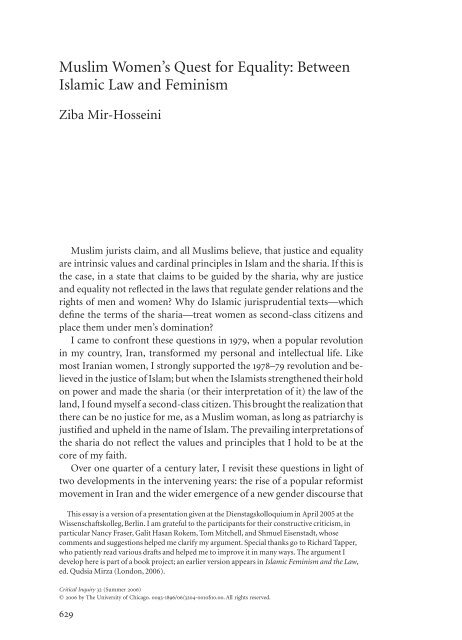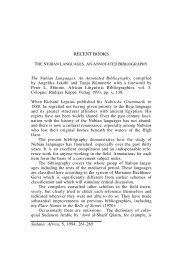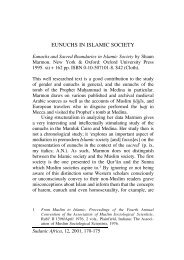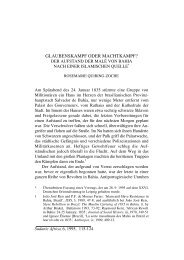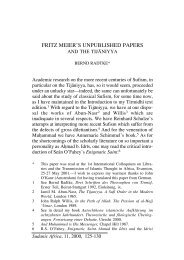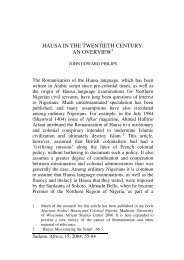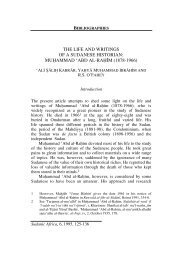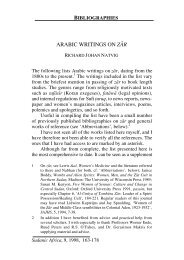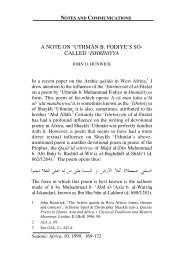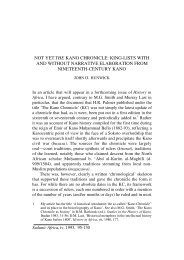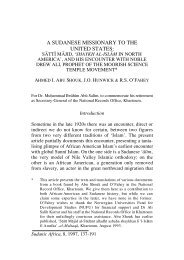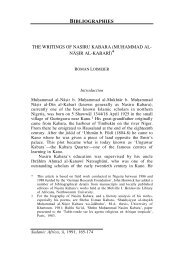Muslim Women's Quest for Equality: Between Islamic Law and ...
Muslim Women's Quest for Equality: Between Islamic Law and ...
Muslim Women's Quest for Equality: Between Islamic Law and ...
You also want an ePaper? Increase the reach of your titles
YUMPU automatically turns print PDFs into web optimized ePapers that Google loves.
<strong>Muslim</strong> Women’s <strong>Quest</strong> <strong>for</strong> <strong>Equality</strong>: <strong>Between</strong><strong>Islamic</strong> <strong>Law</strong> <strong>and</strong> FeminismZiba Mir-Hosseini<strong>Muslim</strong> jurists claim, <strong>and</strong> all <strong>Muslim</strong>s believe, that justice <strong>and</strong> equalityare intrinsic values <strong>and</strong> cardinal principles in Islam <strong>and</strong> the sharia. If this isthe case, in a state that claims to be guided by the sharia, why are justice<strong>and</strong> equality not reflected in the laws that regulate gender relations <strong>and</strong> therights of men <strong>and</strong> women? Why do <strong>Islamic</strong> jurisprudential texts—whichdefine the terms of the sharia—treat women as second-class citizens <strong>and</strong>place them under men’s domination?I came to confront these questions in 1979, when a popular revolutionin my country, Iran, trans<strong>for</strong>med my personal <strong>and</strong> intellectual life. Likemost Iranian women, I strongly supported the 1978–79 revolution <strong>and</strong> believedin the justice of Islam; but when the Islamists strengthened their holdon power <strong>and</strong> made the sharia (or their interpretation of it) the law of thel<strong>and</strong>, I found myself a second-class citizen. This brought the realizationthatthere can be no justice <strong>for</strong> me, as a <strong>Muslim</strong> woman, as long as patriarchy isjustified <strong>and</strong> upheld in the name of Islam. The prevailing interpretations ofthe sharia do not reflect the values <strong>and</strong> principles that I hold to be at thecore of my faith.Over one quarter of a century later, I revisit these questions in light oftwo developments in the intervening years: the rise of a popular re<strong>for</strong>mistmovement in Iran <strong>and</strong> the wider emergence of a new gender discourse thatThis essay is a version of a presentation given at the Dienstagskolloquium in April 2005 at theWissenschaftskolleg, Berlin. I am grateful to the participants <strong>for</strong> their constructive criticism, inparticular Nancy Fraser, Galit Hasan Rokem, Tom Mitchell, <strong>and</strong> Shmuel Eisenstadt, whosecomments <strong>and</strong> suggestions helped me clarify my argument. Special thanks go to Richard Tapper,who patiently read various drafts <strong>and</strong> helped me to improve it in many ways. The argument Idevelop here is part of a book project; an earlier version appears in <strong>Islamic</strong> Feminism <strong>and</strong> the <strong>Law</strong>,ed. Qudsia Mirza (London, 2006).Critical Inquiry 32 (Summer 2006) 2006 by The University of Chicago. 0093-1896/06/3204-0010$10.00. All rights reserved.629
630 Ziba Mir-Hosseini / <strong>Between</strong> <strong>Islamic</strong> <strong>Law</strong> <strong>and</strong> Feminismargues <strong>for</strong> equality within an <strong>Islamic</strong> framework. The questions have acquireda fresh urgency in a new century that has brought an aggressiveunilateralism in the policies of the sole remaining superpower towards theMiddle East <strong>and</strong> Southwest Asia, a rhetoric of “promoting democracy” <strong>and</strong>“human rights” to support military interventions in (so far) Afghanistan<strong>and</strong> Iraq.In Afghanistan, the invasion was a reaction to the al-Qaeda attacks of 11September 2001. It succeeded in bringing down the Taliban government(which was not responsible <strong>for</strong> the attacks) but not in capturing the al-Qaeda leadership. The invasion, occupation, <strong>and</strong> “regime change” were inpart justified to the U.S. (<strong>and</strong> world) public as rescuing Afghan womenfromoppression, vividly represented in their all-enveloping cover, the chadri, orburqa. Many observers were consequently surprised <strong>and</strong> disappointed thatthe downfall of the Taliban did not lead to Afghan women’s mass ab<strong>and</strong>onmentof the burqa. Its persistence was quite rightly judged, however, toreflect the persistence of traditional patriarchal values <strong>and</strong> norms that theTaliban had merely en<strong>for</strong>ced in an extreme <strong>for</strong>m, norms <strong>and</strong> values thatmost Afghan women <strong>and</strong> men continue to associate with Islam <strong>and</strong> thatfew of them are yet ready to ab<strong>and</strong>on in the absence of any credible or palatablealternative set of values. Indeed, the family law establishedintheyearssince the invasion enshrines the very same values despite the emergence onthe political scene of a significant number of brave Afghan women.In Iraq, when the primary reasons <strong>for</strong> the necessity of a “regime change”(Saddam’s supposed weapons of mass destruction <strong>and</strong> links to al-Qaeda)were discredited, the invaders resorted to magnifying the tyrannical natureof the Baath regime, failing to justify why they had chosen to attack thistyranny rather than the many others, far <strong>and</strong> near. The subsequent occupation<strong>and</strong> attempts to institute “freedom” <strong>and</strong> “democracy” have resultedin the strengthening of traditionalist religious <strong>for</strong>ces intent on bringingfamily law in line with their interpretations of the sharia <strong>and</strong> on dismantlingthe Iraqi Family Code, which st<strong>and</strong>s among the most progressive in theZiba Mir-Hosseini (zibamir@onetel.com) is an independent consultant,researcher, <strong>and</strong> writer on Middle Eastern issues, specializing in gender, familyrelations, <strong>and</strong> <strong>Islamic</strong> law <strong>and</strong> development, <strong>and</strong> is based at the London MiddleEast Institute. In fall 2006, she will be Hauser Global <strong>Law</strong> Visiting Professor at theSchool of <strong>Law</strong>, New York University. Her recent books include Islam <strong>and</strong> Gender:The Religious Debate in Contemporary Iran (1999) <strong>and</strong>, with Richard Tapper,Islam <strong>and</strong> Democracy in Iran: Eshkevari <strong>and</strong> the <strong>Quest</strong> <strong>for</strong> Re<strong>for</strong>m (2006). She hasalso directed (with Kim Longinetto) two feature-length documentary films oncontemporary issues in Iran: Divorce Iranian Style (1998) <strong>and</strong> Runaway (2001).
Critical Inquiry / Summer 2006 631<strong>Muslim</strong> world. 1 As in Afghanistan, it seems that most Iraqi <strong>Muslim</strong>s see theneoimperialist intervention as a direct assault on their religion, which hasgiven a new legitimacy to radical Islamist groups <strong>and</strong> undermined the position<strong>and</strong> discourse of progressive <strong>for</strong>ces.It is debatable (<strong>and</strong> has been much debated) how far, in either Afghanistanor Iraq, the two interventions have resulted in improvements in humanrights in general <strong>and</strong> women’s rights in particular. 2 In short, theexperiences of women in Iran, where a movement <strong>for</strong> democratic re<strong>for</strong>memerged after two decades of sharia as the source of law, have become directlyrelevant to women’s quest <strong>for</strong> equality in the two neighboring countries.There are two main elements to the argument that follows. First, oneparadoxical <strong>and</strong> unintended consequence of the Islamists’ reintroductionof sharia in Iran <strong>and</strong> their attempt to en<strong>for</strong>ce its premodern m<strong>and</strong>ates hasbeen to open a new dialogue between <strong>Islamic</strong> law <strong>and</strong> feminism. This dialogue,in turn, has become a catalyst <strong>for</strong> the emergence of new re<strong>for</strong>mist<strong>and</strong> feminist voices in Islam that are changing the terms of reference of<strong>Islamic</strong> discourses from within. Secondly, without the democratization<strong>and</strong>modernization of Islam’s legal vision, <strong>Muslim</strong> women’s quest <strong>for</strong> equalrights will be held hostage to the <strong>for</strong>tunes of various political tendencies,both internal <strong>and</strong> external.But first a note on my position <strong>and</strong> conceptual framework is in order. Aclear statement of position is needed, as not only the media <strong>and</strong> populardiscourse but also the bulk of academic discussions on Islam <strong>and</strong> womenare replete with rhetoric in the guise of either facts or scholarship. A monolithicview of Islam still dominates both popular <strong>and</strong> academic discourses. 3Too often we hear statements beginning “Islam is,” “the Koran says,” or1. Although the leading religious authority in Iraq, Ayatollah Sistani, differs from the rulingIranian clerics on the proper role of religion in government, his interpretations of the sharia ongender relations <strong>and</strong> family law are more conservative, traditional, <strong>and</strong> patriarchal. His views areavailable on his website (www.sistani.org), which contains his rulings <strong>and</strong> fatwas on family <strong>and</strong>gender relations. For reports on recent developments, see <strong>for</strong> instance Isobel Coleman <strong>and</strong>Mehlaqa Samdani, “Promote Iraqi Women’s Rights within an <strong>Islamic</strong> Framework,” ChristianScience Monitor, 14 Oct. 2005, p. 9; Edmund S<strong>and</strong>ers, “The Conflict in Iraq: <strong>Islamic</strong> Slant inthe Charter Is Decried,” Los Angeles Times, 8 Aug. 2005, p. A1; <strong>and</strong> Coleman, “Women, Islam,<strong>and</strong> the New Iraq,” Foreign Affairs 85 (Jan.–Feb. 2006), http://www.<strong>for</strong>eignaffairs.org/20060101faessay85104/isobel-coleman/women-islam-<strong>and</strong>-the-new-iraq.html2. For a discussion, see Lila Abu-Lughod, “Do <strong>Muslim</strong> Women Really Need Saving?Anthropological Reflections on Cultural Relativism <strong>and</strong> Its Others,” American Anthropologist 194(Sept. 2002): 783–90, <strong>and</strong> Roksana Bahramitsh, “The War on Terror, Feminist Orientalism, <strong>and</strong>Orientalist Feminism: Case Studies of Two North American Bestsellers,” Critique 14 (2005):221–35.3. See Mir-Hosseini, Islam <strong>and</strong> Gender: The Religious Debate in Contemporary Iran (Princeton,N.J., 1999), pp. 3–6.
632 Ziba Mir-Hosseini / <strong>Between</strong> <strong>Islamic</strong> <strong>Law</strong> <strong>and</strong> Feminism“according to <strong>Islamic</strong> law or sharia.” Too rarely do those who speak in thename of Islam admit that theirs is no more than one opinion or interpretationamong many. The holy texts, <strong>and</strong> the laws derived from them, arematters of human interpretation. Moreover, those who talk of Islam, orindeed of religion in relation to Islam, fail to make a distinction now commonwhen talking of religion in other contexts, namely, between faith (<strong>and</strong>its values <strong>and</strong> principles) <strong>and</strong> organized religion (institutions, laws, <strong>and</strong>practices). The result is the pervasive polemical <strong>and</strong> rhetorical tricks of eitherglorifying a faith without acknowledging the horrors <strong>and</strong> abuses thatare committed in its name or condemning it by equating it with thoseabuses. Of course, religious faith <strong>and</strong> organized religion are linked, but theyare not the same thing, as is implied by conflating them in thelabel“<strong>Islamic</strong>”or “religious.”Though my approach <strong>and</strong> analysis are those of a social anthropologist,I do not claim to be a detached observer. 4 As a believing <strong>Muslim</strong> woman Iam a committed participant in debates over the issue of gender equality inlaw, <strong>and</strong> I place my analysis within the tradition of <strong>Islamic</strong> legal thought byinvoking one crucial distinction in that tradition that has been distorted inmodern times, when modern nation-states have created uni<strong>for</strong>m legal systems<strong>and</strong> selectively re<strong>for</strong>med <strong>and</strong> codified elements of <strong>Islamic</strong> family law<strong>and</strong> when new <strong>for</strong>ms of political Islam that use sharia as an ideology haveemerged. This is the distinction between sharia <strong>and</strong> fiqh. 5In <strong>Muslim</strong> belief, sharia—revealed law, literally “the way”—isthetotalityof God’s will as revealed to the Prophet Muhammad. Fiqh—the science ofjurisprudence, literally “underst<strong>and</strong>ing”—is the process of human endeavorto discern <strong>and</strong> extract legal rules from the sacred sources of Islam—that is, the Koran <strong>and</strong> the Sunna (the practice of the Prophet, as containedin hadith, Traditions). In other words, while the sharia is sacred, universal,<strong>and</strong> eternal, fiqh is human <strong>and</strong>—like any other system of jurisprudence—subject to change. Fiqh is often mistakenly equated with sharia, both inpopular<strong>Muslim</strong> discourses <strong>and</strong> by politicians <strong>and</strong> academic <strong>and</strong> legalspecialists, <strong>and</strong> often with ideological intent; that is, what Islamists <strong>and</strong> othersassert to be a sharia m<strong>and</strong>ate (hence divine <strong>and</strong> infallible) is the result4. For the development of my own position <strong>and</strong> approach, see Mir-Hosseini, preface, Islam <strong>and</strong>Gender, pp. xi–xx <strong>and</strong> preface, Marriage on Trial: A Study of <strong>Islamic</strong> Family <strong>Law</strong> in Iran <strong>and</strong>Morocco, 2d ed. (London, 2000), pp. vii–xi.5. For this distinction, see Muhammad Hashim Kamali, “Sources, Nature, <strong>and</strong> Objectives ofShari‘ah,” <strong>Islamic</strong> Quarterly 33, no. 4 (1989): 216, <strong>and</strong> Khaled Abou El Fadl, Speaking in God’sName: <strong>Islamic</strong> <strong>Law</strong>, Authority, <strong>and</strong> Women (Ox<strong>for</strong>d, 2001), pp. 32–35. For an argument notemploying the distinction, see Abdullahi An-Na’im, “<strong>Islamic</strong> Foundation <strong>for</strong> Women’s HumanRights,” in Islam, Reproductive Health, <strong>and</strong> Women’s Rights, ed. Zainah Anwar <strong>and</strong> RashidaAbdullah (Kuala Lumpur, 2000), pp. 33–34.
Critical Inquiry / Summer 2006 633of fiqh, juristic speculation <strong>and</strong> extrapolation (hence human <strong>and</strong> fallible).Fiqh texts, which are patriarchal in both spirit <strong>and</strong> <strong>for</strong>m, are frequently invokedas God’s law, as a means to silence <strong>and</strong> frustrate <strong>Muslim</strong>s’ search <strong>for</strong>legal justice <strong>and</strong> equality, which are intrinsic to this-worldly justice.It is essential, I maintain, to highlight this distinction <strong>and</strong> to draw attentionto its epistemological <strong>and</strong> political ramifications. It underlies theemergenceof various schools of <strong>Islamic</strong> law <strong>and</strong> within them a multiplicity ofpositions <strong>and</strong> opinions <strong>and</strong> also enables me—as a <strong>Muslim</strong>—to argue <strong>for</strong>gender justice within the framework of my faith. 6 I contend that patriarchalinterpretations of the sharia can <strong>and</strong> must be challenged at the level of fiqh,which is nothing more than the human underst<strong>and</strong>ing of the divine will,that is, what we are able to underst<strong>and</strong> of the sharia in this world at the legallevel. In other words, sharia is the transcendental ideal that embodies thejustice of Islam <strong>and</strong> the spirit of the Koranic revelations.Thistranscendentalideal, which condemns all relations of exploitation <strong>and</strong> domination, underpins<strong>Muslim</strong> women’s quest <strong>and</strong> the critique of patriarchal constructionsof gender relations, which are to be found not only in the vast corpusof jurisprudential texts but also in the positive laws that are claimed to berooted in the sacred texts.Family <strong>Law</strong>, Women, <strong>and</strong> the Re<strong>for</strong>m Movement in IranIn 1979 one version of the Islamist vision was realized in Iran. A popularrevolution ended 2500 years of monarchy <strong>and</strong> gave birth to an <strong>Islamic</strong> republic,which took the <strong>for</strong>m of a peculiar combination of theocracy <strong>and</strong>democracy, unprecedented in <strong>Islamic</strong> history. Religious <strong>and</strong> political authorityconverged, <strong>and</strong> the state embarked on a fierce process of Islamization.Within two decades the heirs of the revolution were engaged in a bitterstruggle over its legacy, an argument over the role of Islam in politics <strong>and</strong>the proper scope of fiqh rules in defining social norms <strong>and</strong> regulating personalrelations.6. For a discussion of conceptions of justice in <strong>Islamic</strong> texts, see Majid Khadduri, The <strong>Islamic</strong>Conception of Justice (Baltimore, 1984). In brief, there are two schools of theology <strong>and</strong> thought.The dominant Ash‘ari school holds that our notion of justice is contingent on religious texts;whatever they say is just <strong>and</strong> not open to question. The Mu‘tazili school, on the other h<strong>and</strong>, arguesthat the value of justice exists independent of religious texts; our sense <strong>and</strong> definition of justice isshaped by sources outside religion, is innate, <strong>and</strong> has a rational basis. I adhere to the secondposition, as developed by Abdolkarim Soroush, the Iranian re<strong>for</strong>mist philosopher. According toSoroush, we accept religion because it is just, <strong>and</strong> any religious texts or laws that defy ourcontemporary sense of justice or its definition should be reinterpreted in the light of an ethicalcritique of their religious roots. In other words religion <strong>and</strong> the interpretation of religious texts arenot above justice <strong>and</strong> ethics. In summer 2004, Soroush expounded his argument in a series of fourlectures at Amir-Kabir University, Tehran, entitled “Religious Society, Ethical Society.”
634 Ziba Mir-Hosseini / <strong>Between</strong> <strong>Islamic</strong> <strong>Law</strong> <strong>and</strong> FeminismThe unexpected victory of Mohammad Khatami in the 1997 presidentialelections also brought about a popular re<strong>for</strong>mist movement that sought agradual withdrawal of religion from state authority <strong>and</strong> a shift from atheocratic towards a democratic basis of the <strong>Islamic</strong> republic. This unleasheda power struggle among the ruling elite, <strong>and</strong> <strong>for</strong> about eight yearsthere was a dual state. There were two main camps: the conservatives <strong>and</strong>the re<strong>for</strong>mists. The <strong>for</strong>mer, representing the theocratic side of the state,saw their survival <strong>and</strong> their hold on power as dependent on keeping theideological construction of “Islam” intact <strong>and</strong> on suppressing the latter,who wanted to reconcile Islam with notions of democracy <strong>and</strong> humanrights. The re<strong>for</strong>mists were represented by Khatami’s ministers <strong>and</strong> theelected Sixth Parliament (2000–2004). 7 The theocratic <strong>for</strong>ces won backparliament in 2004 <strong>and</strong> brought the dual state to an end in June 2005,when one of their c<strong>and</strong>idates, the hard-liner Mahmud Ahmadinejad, wonthe presidential election. The means by which the theocrats regained theirmonopoly of state power undermined the popular legitimacy <strong>and</strong> m<strong>and</strong>ateon which the <strong>Islamic</strong> Republic had so far rested. The 2005 presidentialelection was the latest stage of a power struggle that is far from settled, <strong>and</strong>the next stage is, as of this moment, uncertain.Why <strong>and</strong> how has this theocracy produced its own antithesis? There is ahost of factors at work upon which I cannot elaborate here, but the majorelements are encapsulated in the tension between theocratic <strong>and</strong> democraticprinciples, a tension that is inherent in the very quest <strong>for</strong> an <strong>Islamic</strong>state in modern times. What is usually considered to define a state as<strong>Islamic</strong>is adherence to, <strong>and</strong> implementation of, the sharia, held up as the perfectlaw embodying the justice of Islam. But in practice in Iran—as in otherstates (such as Pakistan, Sudan, <strong>and</strong> Saudi Arabia) making the sameclaim—this has amounted to little more than en<strong>for</strong>cing a dress code <strong>for</strong> women <strong>and</strong>applying an outdated patriarchal <strong>and</strong> tribal model of social relationsthrough courts dealing with penal cases <strong>and</strong> familial disputes. In Iran, theresults have been so out of touch with contemporary social realities, withpeople’s sense of justice, <strong>and</strong> with women’s aspirations that both clerics <strong>and</strong>laypeople have been <strong>for</strong>ced to rethink notions of the sharia as an immutablebody of law <strong>and</strong> to redefine their relationship with it.Nowhere has this been more evident than in the area of family law—themost developed field of fiqh, where the boundary between sacred <strong>and</strong> temporalhas been most blurred. One of the early communiqués issued by AyatollahKhomeini’s office, on 26 February 1979, barely two weeks after the7. For an analysis of this period <strong>and</strong> the re<strong>for</strong>m movement in Iran through the work of oneof its clerical advocates, see Mir-Hosseini <strong>and</strong> Richard Tapper, Islam <strong>and</strong> Democracy in Iran:Eshkevari <strong>and</strong> the <strong>Quest</strong> <strong>for</strong> Re<strong>for</strong>m (London, 2006).
Critical Inquiry / Summer 2006 635collapse of the Pahlavi regime, announced the restoration of sharia familylaw through the dismantling of the Family Protection <strong>Law</strong> <strong>and</strong> the reinstatementof the fiqh provisions <strong>for</strong> marriage <strong>and</strong> divorce (codified in 1935as part of the Iranian Civil Code). 8 The Family Protection <strong>Law</strong> of 1967 (<strong>and</strong>its 1975 amendments) had abolished men’s right to talaq (repudiation), restrictedtheir right to polygamy, <strong>and</strong> placed men <strong>and</strong> women on more orless the same legal footing in terms of access to divorce <strong>and</strong> custody rights.Khomeini’s office in 1979 restored the sharia in order to “protect the family”<strong>and</strong> realize women’s “high status” in Islam.But this was not how women perceived <strong>and</strong> experienced the changes. InOctober 1980, when I first started attending the Tehran branches of the newfamily courts, now presided over by <strong>Islamic</strong> judges, women who came tocourt were astonished to learn that their husb<strong>and</strong>s could now divorce themwithout first securing their consent. Some remained incredulous<strong>and</strong>wouldask more than one judge: Can he really divorce me, if I don’t agree? Is thiswhat the sharia says? In 1985, when I resumed my court attendance,women,although no longer incredulous, were insistent on voicing their discontent;some used every occasion to remind the <strong>Islamic</strong> judge of his role as custodianof the sharia <strong>and</strong> of the injustice of a system which could af<strong>for</strong>d themno protection. It was common to hear women ask the judge, Is this howIslam honors women? Is this the justice of Islam, that he can dispose of menow that I have lost my youth <strong>and</strong> replace me with a younger wife? To thesequestions, the judges had no answer, especially when a man insisted on exercisinghis right to divorce a wife who was entirely dependent upon him,with no other source of income <strong>and</strong> nowhere else to go. Some judges—though certainly not all—experienced a moral dilemma. Not only did theyhave to witness the plight of women on a daily basis, but they could nothelp but feel implicated themselves. The <strong>Islamic</strong> judges in whose courts Isat in the 1980s often told me that I had chosen the wrong place to learnabout the sharia. I should to go to the seminaries, they said, to read fiqhtexts <strong>and</strong> discuss them with the ulama; the courts had nothing to teach meabout the sharia.In 1997, when I returned to the Tehran courts to make a documentaryfilm about divorce, 9 there was little trace of the idealism I had encounteredin the 1980s. Meanwhile, the en<strong>for</strong>cement of patriarchal fiqh notionsofmarriage<strong>and</strong> divorce had created such havoc in family life, such an uproaramong women, that the government had been <strong>for</strong>ced to restore almost all8. See In the Shadow of Islam: The Women’s Movement in Iran, ed. Azar Tabari <strong>and</strong> NahidYeganeh (London, 1982), p. 232.9. The name of this film is Divorce Iranian Style, dir. Mir-Hosseini <strong>and</strong> Kim Longinotto(London, 1998).
636 Ziba Mir-Hosseini / <strong>Between</strong> <strong>Islamic</strong> <strong>Law</strong> <strong>and</strong> Feminismthe re<strong>for</strong>ms that had been dismantled overnight by that singlecommuniquéfrom Ayatollah Khomeini’s office. This was done through a series of legislativemeasures <strong>and</strong> procedural devices whose spirit <strong>and</strong> juristic logic wasmeant to protect <strong>and</strong> reward those women who presented no overt challengeto the patriarchal ethos of <strong>Islamic</strong> law as defined by classical <strong>Muslim</strong>jurists. To exercise his so-called <strong>Islamic</strong> right to divorce, a man now musteither obtain his wife’s consent or pay her substantial compensation. 10Far from producing the intended result—that is, marital harmony or ageneration of docile wives—the “return to sharia” further exposed <strong>and</strong> accentuatedthe gap between the patriarchal assumptions by which marriageis defined in fiqh <strong>and</strong> the egalitarian marriage lived <strong>and</strong> experienced by mostpeople today. It has also become a bargaining chip in the h<strong>and</strong>s of women,many of whom use it effectively in the courts; some succeed in using thevery elements that give men power in marriage to make them pay, bothliterally <strong>and</strong> figuratively. In other words, the return to sharia in Iran hasproved, in effect, a major cause of marital breakdown <strong>and</strong> soaring divorcerates. Likewise, the Islamization of other areas of law, in particular the penalcode, has increased the crime rates.New Religious ThinkingBy the late 1980s in Iran, the ideological, theological, theoretical, <strong>and</strong>practical problems brought by the experience of administering premoderninterpretations of fiqh had led to the <strong>for</strong>mulation of a new approach. Themain architect was Abdolkarim Soroush, whose interpretative-epistemologicaltheory of the evolution of religious knowledge—known as the contraction<strong>and</strong> expansion of sharia—posed a serious challenge to bothtraditional <strong>and</strong> ideological constructions of the sharia. Soroush made a distinctionbetween religion <strong>and</strong> religious knowledge <strong>and</strong> argued that,whereasthe first is sacred <strong>and</strong> immutable, the second—including <strong>Islamic</strong> law—ishuman <strong>and</strong> evolves in time because of <strong>for</strong>ces external to religion itself. 11Referred to as New Religious Thinking, this discourse became the intellectualbackbone of the re<strong>for</strong>mist movement that emerged in 1997. It ispart of an older trend of thought that remained dormant during the firstdecade of the <strong>Islamic</strong> Republic, which was then engaged in a war with Iraq.Its advocates now display a refreshingly pragmatic vigor <strong>and</strong> a willingness10. For pre- <strong>and</strong> postrevolutionary family law in Iran, see Mir-Hosseini, “Family <strong>Law</strong> inModern Persia,” Encyclopaedia Iranica, 11 vols., ed. Ehsan Yarshater (Costa Mesa, Calif., 1999),9:192–96.11. For a concise account of this theory, see Soroush, “The Evolution <strong>and</strong> Devolution ofReligious Knowledge,” in Liberal Islam: A Sourcebook, ed. Charles Kurzman (Ox<strong>for</strong>d, 1998), pp.244–54; <strong>for</strong> a selection of his writings in English, see Sourosh, Reason, Freedom, <strong>and</strong> Democracy inIslam: Essential Writings of Abdolkarim Soroush, trans. <strong>and</strong> ed. Mahmoud Sadri <strong>and</strong> Ahmed Sadri(Ox<strong>for</strong>d, 2000).
Critical Inquiry / Summer 2006 637to engage with nonreligious perspectives. They do not reject an idea simplybecause it is Western, nor do they see Islam as having a built-in blueprint<strong>for</strong> solving the social, economic, <strong>and</strong> political problems of the <strong>Muslim</strong>world. 12 They contend that the human underst<strong>and</strong>ing of Islam is flexible,that Islam’s tenets can be interpreted to encourage both pluralism <strong>and</strong> democracy,<strong>and</strong> that Islam allows change in the face of time, space, <strong>and</strong> experience.What is new about the New Religious Thinking in Iran is not its argumentthat fiqh is temporal, a claim made by the great <strong>Muslim</strong> jurist <strong>and</strong>philosopher al-Ghazali as early as the eleventh century. Nor is it its attemptto demonstrate the compatibility of Islam with modernity, which has beenthe aim of all <strong>Muslim</strong> re<strong>for</strong>mers since the late nineteenth century. What isnew is the political context within which these ideas are now shaped <strong>and</strong>within which they operate, that is, the experience of living in a theocracy atthe end of the twentieth century. This experience has <strong>for</strong>cedclerics,religiousintellectuals, <strong>and</strong> ordinary people alike to rethink notions of the sacred <strong>and</strong>the mundane in the sharia. It is not that the sharia is losing its sanctity orthat people are turning away from Islam. Rather, the state’s ideological useof the sharia <strong>and</strong> its penetration into the private lives of individuals havebrought home the urgent need to separate religion from the state.It remains to be seen whether the new religious thinkers—theintellectualbackbone of the re<strong>for</strong>mist movement—will succeed in translating their visionof Islam into a political reality. The dispute with their conservativeopponents has shaken the very foundation on which the <strong>Islamic</strong> Republicrests. But irrespective of the outcome of this struggle, the process of desanctification<strong>and</strong> secularization of fiqh has reached a point of no return.Re<strong>for</strong>mists in Iran have faced <strong>and</strong> continue to face many political setbacks,<strong>and</strong> during their period in office (1997–2005) they failed to bring aboutchanges in the structure of power. But they had one major <strong>and</strong> lasting success:they demystified both the power games conducted in a religious language<strong>and</strong> the instrumental use of religion to justify autocratic rule <strong>and</strong>patriarchal culture.At the start of this new century, Iran is going through a transition, theoutcome of which may prove as significant <strong>for</strong> the <strong>Muslim</strong> world as the 1979revolution itself. It would be one of history’s sharpest ironies if the mostlasting legacy of the 1979 <strong>Islamic</strong> revolution in Iran, which brought clericsto power <strong>and</strong> made the sharia the law of l<strong>and</strong>, were the full separation ofstate <strong>and</strong> religion, an eventuality that scholars like Ernest Gellner arguedwas unlikely to happen in the <strong>Muslim</strong> world. 13 In the end, the very slogan12. For a sample of the textual genealogy of this thinking, see Kurzman, Liberal Islam.13. See Ernest Gellner, “The Importance of Being Modular,” in Civil Society: Theory, History,Comparison, ed. John A. Hall (Cambridge, 1995), p. 39.
638 Ziba Mir-Hosseini / <strong>Between</strong> <strong>Islamic</strong> <strong>Law</strong> <strong>and</strong> FeminismReturn to the Sharia, from which the Islamists draw their legitimacy <strong>and</strong>power when they are in opposition, may become their Achilles heel nowthat they are in power.Another legacy of the <strong>Islamic</strong> revolution in Iran has been the emergenceof an indigenous <strong>Islamic</strong> feminism. Like the re<strong>for</strong>mists, the feminists ofIranhave been theoretically inspired by the New Religious Thinking, while theirwritings have been in<strong>for</strong>med by both their experiences under the <strong>Islamic</strong>Republic <strong>and</strong> the specific politics of gender in Iran. 14 But their quest <strong>for</strong>equality <strong>and</strong> their discourse are parts of a new gender politics among <strong>Muslim</strong>sworldwide, to which I now turn.The Emergence of <strong>Islamic</strong> Feminism<strong>Muslim</strong> women, like other women in the world, have always been awareof—<strong>and</strong> resisted—gender inequality; yet the emergence of a sustained, indigenousfeminism was delayed until recently. This delay at least partly reflectsthe complex relation between women’s dem<strong>and</strong>s <strong>for</strong> equal rights <strong>and</strong>the anticolonial, nationalist movement of the first part of the twentiethcentury.At a time when feminism, both as a consciousness <strong>and</strong> as a movement,was being shaped <strong>and</strong> making an impact in Europe <strong>and</strong> North America, italso “functioned to morally justify the attacks on native (<strong>Muslim</strong>) societies<strong>and</strong> to support the notion of the comprehensive superiority of Europe,” asLeila Ahmed among others has shown. 15Nineteenth-century European travellers <strong>and</strong> diplomats regularly reportedon what they considered the subjection of women in <strong>Muslim</strong> societies.The rise of anticolonialist <strong>and</strong> nationalist movements put <strong>Muslim</strong>s onthe defensive with regard to traditional gender relations. The situation wasfurther complicated by the rise of modern nation-states in the <strong>Muslim</strong>world <strong>and</strong> their appropriation of Islam <strong>and</strong> the “woman question” in theprocess of nation building. New regimes not only selectively re<strong>for</strong>med theclassical rules of <strong>Islamic</strong> family law, grafting them onto a unified legal system;they also tried to define the scope of women’s rights <strong>and</strong> to controlnascent women’s activism. The degree to which they succeeded or failed inthis varied from country to country <strong>and</strong> from one period to another. 1614. See, <strong>for</strong> instance, Azadeh Kian, “Women <strong>and</strong> Politics in Post-Revolutionary Iran: TheGender-Conscious Drive to Change,” Women Living under <strong>Muslim</strong> <strong>Law</strong>s 21 (July 1998): 32–55; Mir-Hosseini, “Stretching the Limits: A Feminist Reading of the Shari‘a in Post-Khomeini Iran,” inIslam <strong>and</strong> Feminism: Legal <strong>and</strong> Literary Perspectives, ed. Mai Yamani (London, 1996), pp. 285–319;Afsaneh Najmabadi, “Feminism in an <strong>Islamic</strong> Republic: ‘Years of Hardship, Years of Growth,’” inIslam, Gender, <strong>and</strong> Social Change, ed. Yvonne Haddad <strong>and</strong> John Esposito (Ox<strong>for</strong>d, 1998), pp. 59–89; <strong>and</strong> Parvin Paidar, “Feminism <strong>and</strong> Islam in Iran,” in Gendering the Middle East: EmergingPerspectives, ed. Deniz K<strong>and</strong>iyoti (London, 1996), pp. 51–68.15. Leila Ahmed, Women <strong>and</strong> Gender in Islam: Historical Roots of a Modern Debate (NewHaven, Conn., 1992), p. 154.16. See Mounira Charrad, States <strong>and</strong> Women’s Rights: The Making of Postcolonial Tunisia,Algeria, <strong>and</strong> Morocco (Berkeley, 2001); Women, Islam, <strong>and</strong> the State, ed. K<strong>and</strong>iyoti (Basingstoke,
Critical Inquiry / Summer 2006 639<strong>Muslim</strong> women who acquired a feminist consciousness at the time <strong>and</strong>who sought equal rights <strong>for</strong> women were under pressure to con<strong>for</strong>m toanticolonialist <strong>and</strong> nationalist priorities, as well as to the secularist, modernist,yet despotic agenda of the new states. Some scholars have arguedthatat the start of the twentieth century the boundary between Islam <strong>and</strong> feminismwas not so clearly marked <strong>and</strong> that women often tried to change traditionallaws by invoking <strong>and</strong> relying on Islam’s sacred texts. 17 But it was inthis period too that women became symbols of cultural authenticity <strong>and</strong>carriers of a religious tradition <strong>and</strong> way of life, which meant that any dissenton their part could be construed as a kind of betrayal or could be silenced.Contemporary Western feminists could criticize the patriarchal elementsof their own cultures <strong>and</strong> religions in the name of modernity, liberalism,<strong>and</strong> democracy, but <strong>Muslim</strong>s could not draw on these external ideologiesor on internal political ideologies in their fight <strong>for</strong> equal rights. For boththe colonialists <strong>and</strong> the modernizing secularists, <strong>Islamic</strong> law was the embodimentof a backward system that had to be rejected or tamed in thenameof progress. For anticolonialists <strong>and</strong> most nationalists, feminism—that is,advocacy of women’s rights—was a colonialist project that had to be resisted.Meanwhile, undemocratic <strong>Muslim</strong> “modernists” gave a new legal<strong>for</strong>ce to the gender inequalities prescribed by classical <strong>Islamic</strong> jurists. As aconsequence, many <strong>Muslim</strong> women faced a painful choice, as Ahmed putsit, “between betrayal <strong>and</strong> betrayal.” 18 They had to choose between their<strong>Muslim</strong> identity—their faith—<strong>and</strong> their new gender awareness.But as the twentieth century drew to a close, this dilemma disappeared.One neglected <strong>and</strong> paradoxical consequence of the rise of political Islam inthe second half of the century was that it helped to create a space, an arena,within which <strong>Muslim</strong> women could reconcile their faith <strong>and</strong> identity witha struggle <strong>for</strong> gender equality. This did not happen because the Islamistsoffered an egalitarian vision of gender relations; in fact, they did not.Rather,their very agenda—the so-called return to sharia—<strong>and</strong> their attempt totranslate into policy the patriarchal gender notions inherent in traditional<strong>Islamic</strong> law provoked many women to increasing criticism of these notions<strong>and</strong> spurred them to greater activism. A growing number of women cameto see no inherent or logical link between <strong>Islamic</strong> ideals <strong>and</strong> patriarchy, nocontradiction between <strong>Islamic</strong> faith <strong>and</strong> feminism, <strong>and</strong> to free themselvesEngl<strong>and</strong>, 1991); <strong>and</strong> Paidar, Women <strong>and</strong> the Political Process in Twentieth-Century Iran (Cambridge,1995).17. On Egypt, see Margot Badran, Feminists, Islam, <strong>and</strong> Nation: Gender <strong>and</strong> the Making ofModern Egypt (Princeton, N.J., 1995). On Iran, see Paidar, Women <strong>and</strong> the Political Process inTwentieth-Century Iran.18. Ahmed, “Early Feminist Movements in the Middle East: Turkey <strong>and</strong> Egypt,” in <strong>Muslim</strong>Women, ed. Freda Hussain (London, 1984), p. 122.
640 Ziba Mir-Hosseini / <strong>Between</strong> <strong>Islamic</strong> <strong>Law</strong> <strong>and</strong> Feminismfrom the straitjacket of earlier anticolonial <strong>and</strong> nationalistdiscourses.Usingthe language of political Islam, they could sustain a critique of the genderbiases in <strong>Islamic</strong> law in ways that were previously impossible.By the late 1980s, there were clear signs of the emergence of a new consciousness,a new way of thinking, a gender discourse that was <strong>and</strong> is feministin its aspiration <strong>and</strong> dem<strong>and</strong>s, yet <strong>Islamic</strong> in its language <strong>and</strong> sourcesof legitimacy. One version of this new discourse has come to be called <strong>Islamic</strong>feminism. 19 The majority of Islamists, however, <strong>and</strong> some secularfeminists, see the notion of <strong>Islamic</strong> feminism as antithetical to their respectivepositions or ideologies <strong>and</strong> in effect as a contradiction in terms.What, then, is <strong>Islamic</strong> feminism? How does it differ from other feminisms?These questions can best be answered by examining the dynamicsof <strong>Islamic</strong> feminism <strong>and</strong> its potential in the <strong>Muslim</strong> world. It is difficult <strong>and</strong>perhaps futile to put the emerging feminist voices in Islam into neat categories<strong>and</strong> to try to generate a definition that reflects the diversity of positions<strong>and</strong> approaches of <strong>Islamic</strong> feminists. As with other feminists, theirpositions are local, diverse, multiple, <strong>and</strong> evolving. Many of them have difficultywith the label <strong>and</strong> object to being called either <strong>Islamic</strong> or feminist.They all seek gender justice <strong>and</strong> equality <strong>for</strong> women, though they do notalways agree on what constitutes justice or equality or the best ways of attainingthem.To underst<strong>and</strong> a movement that is still in <strong>for</strong>mation, we might start byconsidering who its opponents are; in other words, we might consider the19. There is a growing literature on <strong>Islamic</strong> feminism <strong>and</strong> its politics. See <strong>for</strong> instance HalehAfshar, Islam <strong>and</strong> Feminisms: An Iranian Case-Study (Basingstoke, Engl<strong>and</strong>, 1998); Badran,“<strong>Islamic</strong> Feminism: What’s in a Name?” Al-Ahram Weekly, 17 Jan. 2002, http://weekly.ahram.org.eg/2002/569/cu1.htm<strong>and</strong> “<strong>Between</strong> Secular <strong>and</strong> <strong>Islamic</strong> Feminisms: Reflections on the MiddleEast <strong>and</strong> Beyond,” Journal of Middle Eastern Women’s Studies 1 (2005): 6–28; Elizabeth Fernea, InSearch of <strong>Islamic</strong> Feminism: One Woman’s Global Journey (New York, 1998); Anouar Majid, “ThePolitics of Feminism in Islam” <strong>and</strong> Valentine Moghadam, “<strong>Islamic</strong> Feminism <strong>and</strong> Its Discontents:Toward a Resolution of the Debate,” in Gender, Politics, <strong>and</strong> Islam, ed. Therese Saliba (Chicago,2002), pp. 15–51; Mir-Hosseini, “<strong>Islamic</strong> <strong>Law</strong> <strong>and</strong> Feminism: The Story of a Relationship,”Yearbook of <strong>Islamic</strong> <strong>and</strong> Middle Eastern <strong>Law</strong> 9 (2002): 34–42; Mirza, “<strong>Islamic</strong> Feminism,Possibilities <strong>and</strong> Limitations,” in <strong>Law</strong> after Ground Zero, ed. John Strawson (London, 2002), pp.108–22; Mirza, <strong>Islamic</strong> Feminism <strong>and</strong> the <strong>Law</strong>; Najmabadi Heba Raouf Ezzat, “The Silent Ayesha:An Egyptian Narrative,” in Globalization, Gender, <strong>and</strong> Religion: The Politics of Women’s Rights inCatholic <strong>and</strong> <strong>Muslim</strong> Contexts, ed. Jane H. Bayes <strong>and</strong> Nayereh Tohidi (New York, 2001), pp. 231–57;Anne Sofie Roald, “Feminist Reinterpretation of <strong>Islamic</strong> Sources: <strong>Muslim</strong> Feminist Theology inLight of the Christian Tradition of Feminist Thought,” in Women <strong>and</strong> Islamization: ContemporaryDimensions of Discourse on Gender Relations, ed. Karen Ask <strong>and</strong> Marit Tjomsl<strong>and</strong> (Ox<strong>for</strong>d, 1998),pp. 17–44; Sa‘diyya Shaikh, “Trans<strong>for</strong>ming Feminism: Islam, Women, <strong>and</strong> Gender Justice” <strong>and</strong>Gwendolyn Zoharah Simmons, “Are We up to the Challenge? The Need <strong>for</strong> a Radical Re-orderingof the <strong>Islamic</strong> Discourse on Women,” in Progressive <strong>Muslim</strong>s: On Justice, Gender, <strong>and</strong> Pluralism, ed.Omid Safi (Ox<strong>for</strong>d, 2003), pp. 147–62, 235–48; <strong>and</strong> Tohidi, “‘<strong>Islamic</strong> Feminism’: Perils <strong>and</strong>Promises,” Mews Review 16 (Fall 2001), http://www.amews.org/review/reviewarticles/tohidi.htm
Critical Inquiry / Summer 2006 641resistance against which it has had to struggle. Opponents of the feministproject in Islam fall into three broad categories: <strong>Muslim</strong> traditionalists, <strong>Islamic</strong>fundamentalists, <strong>and</strong> secular fundamentalists. <strong>Muslim</strong> traditionalistsresist any changes to what they hold to be eternally valid ways sanctionedby an unchanging sharia. <strong>Islamic</strong> fundamentalists—a very broad category—arethose who seek to change current practices by a return to anearlier, “purer” version of the sharia. Secular fundamentalists—who can bejust as dogmatic <strong>and</strong> ideological as religious fundamentalists—deny thatany religious law or social practice can be just or equal.Though adhering to very different ideologies <strong>and</strong> scholarly traditions<strong>and</strong> following very different agendas, all these opponents of the feministproject in Islam share one thing—an essentialist <strong>and</strong> nonhistorical underst<strong>and</strong>ingof Islam <strong>and</strong> <strong>Islamic</strong> law. They fail to recognize that assumptions<strong>and</strong> laws about gender in Islam—as in any other religion—are socially constructed<strong>and</strong> thus historically changing <strong>and</strong> open to negotiation. They resistreadings of <strong>Islamic</strong> law that treat it like any other system of law <strong>and</strong> disguisetheir resistance by mystification <strong>and</strong> misrepresentation. Selective in theirarguments <strong>and</strong> illustrations, the three kinds of opponents resort to thesamekinds of sophistry; <strong>for</strong> example, they seek to close discussion by producingKoranic verses or Traditions (hadith) taken out of context. <strong>Muslim</strong> traditionalists<strong>and</strong> <strong>Islamic</strong> fundamentalists do this as a means of silencing otherinternal voices <strong>and</strong> abuse the authority of the text <strong>for</strong> authoritarian purposes.Secular fundamentalists do the same, but in the name of enlightenment,progress, <strong>and</strong> science—<strong>and</strong> as a means of showing the misogynyof Islam—while ignoring the contexts in which the texts were produced, aswell as the existence of alternative texts. In so doing, they end up essentializing<strong>and</strong> perpetuating difference <strong>and</strong> reproduce a crude version of theOrientalist narrative of Islam. 20What is often missing in these narratives is a recognition that genderinequality in the old world was assumed <strong>and</strong> that perceptions of women inChristian <strong>and</strong> Jewish texts are not that different from those of <strong>Islamic</strong> texts.The early Western feminists too found it necessary to confront <strong>and</strong> challengethese perceptions, <strong>and</strong> they did so not by rejecting the Bible or theirfaith but by appealing to its higher values <strong>and</strong> principles. In the eighteenthcentury, Mary Wollstonecraft in A Vindication of the Rights of Woman (1792)often referred to biblical passages when defending women’s essential equalitywith men <strong>and</strong> in refuting the enlightenment philosophers’ argumentson women’s nature as essentially different from men’s. A century later, Eliz-20. See Haideh Moghissi, Feminism <strong>and</strong> <strong>Islamic</strong> Fundamentalism: The Limits of PostmodernAnalysis (London, 1999).
642 Ziba Mir-Hosseini / <strong>Between</strong> <strong>Islamic</strong> <strong>Law</strong> <strong>and</strong> Feminismabeth Cady Stanton placed the dem<strong>and</strong> <strong>for</strong> equal rights <strong>for</strong> women squarelywithin a religious framework <strong>and</strong> went as far as writing The Women’s Bible(1895). These became part of new political <strong>and</strong> socioeconomic discoursesthat were shaped by new social conditions <strong>and</strong> in turn shaped new underst<strong>and</strong>ingsof sacred texts <strong>and</strong> a woman’s situation in the West. 21The work of the <strong>Islamic</strong> feminists should be examined in this light. Byboth uncovering a hidden history <strong>and</strong> rereading textual sources, they areproving that the inequalities embedded in fiqh are neither manifestationsof divine will nor cornerstones of an irredeemably backward social system;rather, they are human constructions. They are also showing how such unequalconstructions contradict the very essence of divine justice as revealedin the Koran <strong>and</strong> how Islam’s sacred texts have been taintedbytheideologiesof their interpreters. 22 For example, they show how men’s unilateral rightsto divorce (talaq) <strong>and</strong> polygyny were not granted to them by God but by<strong>Muslim</strong> male jurists. These are juristic constructs that follow from the waythat early <strong>Muslim</strong> jurists conceptualized <strong>and</strong> defined marriage.The majority of these feminist scholars have focused their energy on thefield of Koranic interpretation (tafsir) <strong>and</strong> have successfully uncovered theKoran’s egalitarian message. The genesis of gender inequality in <strong>Islamic</strong> legaltradition, these scholars tell us, lies in the cultural norms of early<strong>Muslim</strong>societies. 23 While the ideals of Islam call <strong>for</strong> freedom, justice, <strong>and</strong> equality,<strong>Muslim</strong> norms <strong>and</strong> social structures in the <strong>for</strong>mative years of <strong>Islamic</strong> law21. Given the centrality of law in Judaism, there are interesting parallels <strong>and</strong> differences in theways in which <strong>Muslim</strong> <strong>and</strong> Jewish feminists deal with patriarchal laws legitimated throughreligious tradition. On Jewish feminism, see On Being a Jewish Feminist, ed. Susannah Heschel(New York, 1995).22. In addition to works mentioned in note 19, see Azizah Al-Hibri, “Islam, <strong>Law</strong>, <strong>and</strong> Custom:Redefining <strong>Muslim</strong> Women’s Rights,” American University Journal of International <strong>Law</strong> <strong>and</strong> Policy12, no. 1 (1997): 1–44; Kecia Ali, “Progressive <strong>Muslim</strong>s <strong>and</strong> <strong>Islamic</strong> Jurisprudence: The Necessity <strong>for</strong>Critical Engagement with Marriage <strong>and</strong> Divorce <strong>Law</strong>,” in Progressive <strong>Muslim</strong>s, pp. 163–89; AsgharAli Engineer, The Rights of Women in Islam (London, 1992); Farid Esack, “Islam <strong>and</strong> GenderJustice: Beyond Simplistic Apologia,” in What Men Owe to Women: Men’s Voices from WorldReligions, ed. John C. Raines <strong>and</strong> Daniel C. Maguire (Albany, N.Y., 2001), pp. 187–210; HaifaaJawad, The Rights of Women in Islam: An Authentic Approach (Basingstoke, Engl<strong>and</strong>, 1998); Mir-Hosseini, “The Construction of Gender in <strong>Islamic</strong> Legal Thought <strong>and</strong> Strategies <strong>for</strong> Re<strong>for</strong>m,”Hawwa 1, no. 1 (2003): 1–28; <strong>and</strong> Amira El-Azhary Sonbol, “Rethinking Women <strong>and</strong> Islam,” inDaughters of Abraham: Feminist Thought in Judaism, Christianity, <strong>and</strong> Islam, ed. Haddad <strong>and</strong>Esposito (Gainesville, Fla., 2001), pp. 108–46.23. See, <strong>for</strong> instance, Asma Barlas, “Believing Women” in Islam: Unreading PatriarchalInterpretations of the Qur’an (Austin, 2002); Riffat Hassan, “Equal be<strong>for</strong>e Allah? Woman-Man<strong>Equality</strong> in the <strong>Islamic</strong> Tradition,” Selected Articles (Grabels, France, 1987), pp. 12–24; FatimaMernissi, Women <strong>and</strong> Islam: An Historical <strong>and</strong> Theological Enquiry, trans. Mary Jo Lakel<strong>and</strong>(Ox<strong>for</strong>d, 1991); Shaikh, “Exegetical Violence: Nushuz in Qur’anic Gender Ideology,” Journal <strong>for</strong><strong>Islamic</strong> Studies 17 (1997): 49–73; <strong>and</strong> Amina Wadud, Qur’an <strong>and</strong> Woman: Rereading the Sacred Textfrom a Woman’s Perspective (New York, 1999).
Critical Inquiry / Summer 2006 643impeded their realization. Instead, these norms were assimilated into <strong>Islamic</strong>jurisprudence through a set of theological, legal, <strong>and</strong> social theoriesbased on certain underlying assumptions: women are created of men <strong>and</strong><strong>for</strong> men; women are inferior to men; women need to be protected; men areguardians <strong>and</strong> protectors of women; <strong>and</strong> male <strong>and</strong> female sexuality differ<strong>and</strong> the latter is dangerous to the social order. These assumptions <strong>and</strong> theoriesare nowhere more evident than in the rules that define the <strong>for</strong>mation<strong>and</strong> termination of marriage, through which gender inequalities are sustainedin present-day <strong>Muslim</strong> societies. In my own work on marriage <strong>and</strong>divorce, I have tried to engage these juristic assumptions to show how thescience of <strong>Islamic</strong> jurisprudence became the prisoner of its own legal theories,which in time has come to bypass the Koranic call <strong>for</strong> justice <strong>and</strong>re<strong>for</strong>m.Conclusions <strong>and</strong> ImplicationsBe<strong>for</strong>e considering the implications of my account of <strong>Muslim</strong> women’squest <strong>for</strong> equality in a global politics shaped by the so-called war on terror,let me suggest some answers to my opening questions, which I now rephrase.Can sharia <strong>and</strong> feminism coexist? If so, how, <strong>and</strong> by what means<strong>and</strong> processes?I have pursued these questions in the contexts of the re<strong>for</strong>mistmovementin Iran <strong>and</strong> the emerging feminist voices in Islam, which are both part of alarger intellectual <strong>and</strong> ideological struggle among <strong>Muslim</strong>s over two opposedunderst<strong>and</strong>ings of their religion <strong>and</strong> two ways of relating to its sacredtexts. One is an absolutist <strong>and</strong> legalistic Islam, as understood <strong>and</strong> constructedin traditional fiqh, which makes little concession to contemporaryrealities <strong>and</strong> the aspirations of <strong>Muslim</strong>s. The other is a pluralistic <strong>and</strong> tolerantIslam that is making room <strong>for</strong> these realities <strong>and</strong> values, includinggender equality. 24 The struggle over interpretations of Islam’s sacred textshas shaped <strong>Islamic</strong> history <strong>and</strong> civilization <strong>and</strong> undoubtedly will continueto do so. Since the early twentieth century the issue of women’s rights hasbeen central to this struggle, reflecting both modern realities <strong>and</strong> thechanged status of <strong>Muslim</strong> women.The emergence of new feminist voices in Islam in the late 1980s was theinception of the latest stage in this struggle. By advocating a br<strong>and</strong> of feminismthat takes Islam as the source of its legitimacy, these feminist voicesare effectively challenging the hegemony of patriarchal interpretations of24. This struggle is not confined to Iran or to the Shi‘a branch of Islam. For two recent accountsof its unfolding in history <strong>and</strong> other contexts, see Reza Aslan, No God but God: The Origins,Evolution, <strong>and</strong> Future of Islam (New York, 2005), <strong>and</strong> Remaking <strong>Muslim</strong> Politics: Pluralism,Contestation, Democratization, ed. Robert Hefner (Princeton, N.J., 2005).
644 Ziba Mir-Hosseini / <strong>Between</strong> <strong>Islamic</strong> <strong>Law</strong> <strong>and</strong> Feminismthe sharia <strong>and</strong> the legitimacy of the views of those who until now have spokenin the name of Islam. Such a challenge has been made possible, eveninevitable, by the Islamists’ call <strong>for</strong> a return to sharia <strong>and</strong> attempts toimposeanachronistic jurisprudential constructions of gender relations. This callhas placed <strong>Islamic</strong> feminism in a unique position to bring about a muchneededparadigm shift in <strong>Islamic</strong> law. It exposes the inequalities embeddedin current interpretations of sharia—fiqh—as constructions by male juristsrather than manifestations of the divine will. This exposure can have importantepistemological <strong>and</strong> political consequences: epistemological, because,if taken to its logical conclusion, one can argue that some rules thatuntil now have been claimed as <strong>Islamic</strong> <strong>and</strong> part of the sharia are in factonly the views <strong>and</strong> perceptions of some <strong>Muslim</strong>s <strong>and</strong> are social practices<strong>and</strong> norms that are neither sacred nor immutable but human <strong>and</strong> changing;political, because it can both free <strong>Muslim</strong>s from taking a defensive position<strong>and</strong> enable them to go beyond old fiqh dogmas in search of new questions<strong>and</strong> new answers.Can a feminist discourse that takes its legitimacy from Islam’s sacredtexts <strong>and</strong> that must operate within a closed legal system like fiqh, with littlesupport from the power base in that tradition, break that closed systemapart? In other words, can its advocates nurture a gender discourse thatmeets women’s aspirations <strong>for</strong> equality? My answer to this question is aqualified yes, <strong>for</strong> three reasons.First, given the current realities of the <strong>Muslim</strong> world, in which the Islamistshave the upper h<strong>and</strong> in defining the terms of reference of political<strong>and</strong> gender discourses, I would maintain that only those who are preparedto engage with Islam’s sacred texts <strong>and</strong> its legal tradition can bring changefrom within. Otherwise, <strong>Muslim</strong> women’s quest <strong>for</strong> equality will remain ahostage to the <strong>for</strong>tunes of various political <strong>for</strong>ces <strong>and</strong> tendencies, as was thecase in the twentieth century. In my view, secular feminism in the <strong>Muslim</strong>world fulfilled its historical role by paving the way <strong>for</strong> women’s entry intopolitics <strong>and</strong> society in the early twentieth century. But since the rise of politicalIslam in the second part of the century, the battle between tradition<strong>and</strong> modernity in which <strong>Muslim</strong> women are still caught must be conductedin a religious language <strong>and</strong> framework, where jurisprudentialconstructionsof gender can be reexamined <strong>and</strong> the patriarchal m<strong>and</strong>ates of fiqh can bechallenged. The legal gains <strong>and</strong> losses of women in Iran, <strong>and</strong> now in Afghanistan<strong>and</strong> Iraq, testify to the fact that there can be no sustainable gainsunless patriarchal notions of family <strong>and</strong> gender relations are debated, challenged,<strong>and</strong> redressed within an <strong>Islamic</strong> framework.Second, the emerging feminist voices in Islam have the potential to overcomethe dichotomy between “Islam” <strong>and</strong> feminism, which has been a fea-
Critical Inquiry / Summer 2006 645ture of the politics of gender among <strong>Muslim</strong>s in modern times. Thisdichotomy—itself a colonial legacy—is false <strong>and</strong> at times arbitrary, as An-Na’im reminds us. 25 But its implications are too grave <strong>and</strong> too perniciousto be ignored—especially in the context of the neoimperialist war on terror,which many <strong>Muslim</strong>s perceive to be directed against them once again. Sucha perception—whether justified or not—not only puts them on the defensive<strong>and</strong> makes them more likely to cling to religious tradition; it also erodesthe credibility <strong>and</strong> moral high ground of secular <strong>and</strong> Western discourses.<strong>Islamic</strong> feminism has a positive role to play in such a context because, inMargot Badran’s words, it “transcends <strong>and</strong> destroys old binaries that havebeen constructed. These included polarities between religious <strong>and</strong> secular<strong>and</strong> between ‘East’ <strong>and</strong> ‘West.’” 26Finally, the daily lives of many <strong>Muslim</strong> women <strong>and</strong> their life choices—whether they live in an <strong>Islamic</strong> state or as part of a diaspora in a Westernliberal state—are governed <strong>and</strong> shaped by a set of patriarchal beliefs <strong>and</strong>laws <strong>for</strong> which divine roots <strong>and</strong> m<strong>and</strong>ates are claimed. Only the elite <strong>and</strong>the minority of highly educated women have the luxury of choice, of rejectingor challenging these beliefs <strong>and</strong> laws. A movement to sever patriarchyfrom <strong>Islamic</strong> ideals <strong>and</strong> sacred texts <strong>and</strong> to give voice to an ethical<strong>and</strong> egalitarian vision of Islam can <strong>and</strong> does empower <strong>Muslim</strong> women fromall walks of life to make dignified choices. This, in the end, is what <strong>Islamic</strong>feminism is about.25. See An-Na’im, “The Dichotomy between Religious <strong>and</strong> Secular Discourse in <strong>Islamic</strong>Societies,” in Faith <strong>and</strong> Freedom: Women’s Human Rights in the <strong>Muslim</strong> World, ed. MahnazAfkhami (London, 1995), pp. 51–60.26. Badran, “<strong>Islamic</strong> Feminism,” p. 3.


